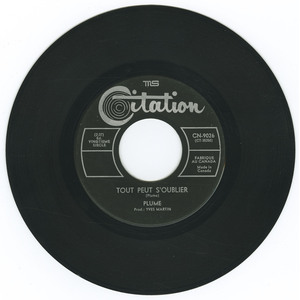Information/Write-up
Sam Lloyd was the recording name of Montréal singer-songwriter Réal Brousseau, whose musical path began in the mid-1960s as a guitarist in Les Monstres, one of Quebec’s earliest and most fully realized “horror rock” groups. Formed out of the yé-yé band Les Shadols, the group adopted B-movie identities—Frankenstein, La Faucheuse, Le Bossu, Le Borgne, and Dracula—and built a stage act around coffins, costumes, ice-cold hands on unsuspecting audience members, and dramatic entrances that placed them somewhere between novelty rock and the emerging garage scene. Behind the masks were musicians who would go on to shape various corners of Québec pop: Marc Hamilton, Normand Bouchard, François Carel, Martin Zizek, Michel Bourgon, and Réal Brousseau.
Les Monstres released two 45s, both now prized by collectors. Their debut, Le Monstre Mash b/w Le Thème du Cimetière, came out in late 1965 on Denis Pantis’s Blue Jean label. It featured a francophone adaptation of Bobby “Boris” Pickett’s Monster Mash and an eerie original instrumental built from clanking chains, reverberated guitar figures, and the macabre ambiance that became their trademark. The follow-up arrived in 1966 on Miracle: Pourquoi Madame b/w Je Veux Une Réponse, co-written by Hamilton, Roger Letarte, and Brousseau. The record moved slightly away from pure novelty into more melodic garage rock, with tight arrangements, brass flourishes, and a stronger pop sensibility. These two singles document Brousseau’s earliest work on vinyl and place him directly within Montréal’s inventive mid-60s teen-club circuit.
In 1967 Brousseau recorded again under the pseudonym Plume, releasing Doctor Robert b/w Tout peut s’oublier on both Carrousel (CR 22) and Citation (CN 9026). These parallel issues marked his transition away from group-based francophone garage toward a more individual songwriting identity, blending anglophone rock references with Quebec pop phrasing.
By the early 1970s Brousseau had moved fully into singer-songwriter territory and adopted the name Sam Lloyd. He became the principal artist on Chart On, a small Montréal label operated by producer Normand Bouchard. Chart On existed briefly between 1971 and 1972 and focused on English-language or crossover material at a time when most Quebec independents centered on francophone pop.
Before Lloyd’s album appeared, Chart On issued a 12-inch promotional single, Piano Piano, promoted as “the biggest 45 from Quebec in ten years,” likely for attention rather than dance-floor use. Lloyd’s self-titled LP followed in 1972 and is now known in two sleeve variations: a blue-tinted close-up portrait and a scarcer sepia-toned psychedelic cover. Brousseau wrote, composed, arranged, and illustrated the album; Bouchard produced, and Michel Bigué provided the photography. With no other musicians credited, the record plays as a one-man studio project, moving through acoustic folk, blues, and lightly electrified tracks with fuzz guitar and double-tracked vocals. Several songs—including Free to Be Free, La liberté, Wah Wah, and Let Him Go—also appeared as singles.
-Robert Williston
Written by John Lennon - Paul McCartney (Doctor Robert); and Sam Lloyd (Tout peut s'oublier)
Produced by Yves Martin



No Comments